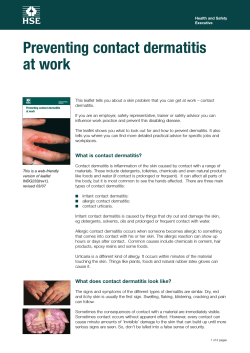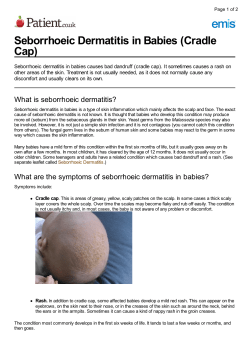
A Multiple Erythematous Papules on a 6-Year-Old’s Face
What’s Your Diagnosis? ® Sharpen Your Physical Diagnostic Skills Multiple Erythematous Papules on a 6-Year-Old’s Face ALEXANDER K. C. LEUNG, MD, and BENJAMIN BARANKIN, MD A 6-year-old boy presented with a 2-month history of a facial eruption. The child was asymptomatic. He has atopic dermatitis and has used topical corticosteroids for the treatment of this condition. around the nasolabial folds and in the perioral area. The lesions spared the vermilion border. The rest of the examination findings were unremarkable. PHYSICAL EXAMINATION What’s your diagnosis? Physical examination revealed multiple erythematous papules Dr. Barankin is medical director and founder of the Toronto Dermatology Centre in Toronto. Alexander K. C. Leung, MD—Series Editor: Dr Leung is clinical professor of pediatrics at the University of Calgary and pediatric consultant at the Alberta Children’s Hospital in Calgary. 464 consultant for pediatricians n October 2013 www.PediatricsConsultant360.com Answer: Perioral dermatitis Perioral dermatitis is a common acneiform eruption on the face that can occur in children and adults.1,2 The condition is characterized by perioral papules, papulovesicles, and/or papulopustules, sparing the vermillion border.3 The condition was first described by Frumess and Lewis in 1957 as light-sensitive seborrheid.4 The term perioral dermatitis was coined by Mihan and Ayres in 1964.5 EPIDEMIOLOGY Perioral dermatitis occurs mainly in children and in young women.1,6 The exact incidence in the general population is not known. In one study, 6% of female patients and 0.3% of male patients seen in dermatology offices in Germany were found to have perioral dermatitis.7 In a prospective, crosssectional, multicenter study of 639 children with asthma treated in France with either inhaled beclomethasone dipropionate or budesonide, 19 (3%) children developed perioral dermatitis.8 Because asthma is a common childhood illness that is frequently treated with inhaled corticosteroids, it is conceivable that perioral dermatitis is also commonly seen in the pediatric age group. In children, the sex ratio is approximately equal.9,10 In the adult population, there is a female predominance.6 All races are affected. ETIOLOGY The exact etiology is not known.11,12 The most common identifiable cause is the use of topical corticosteroids on the face.2,10 Perioral dermatitis also may result from the use of inhaled and, less frequently, nasal or systemic corticosteroids.1,13-15 Patients with an atopic diathesis are particularly susceptible to perioral dermatitis.10 Ultraviolet light, heat, and wind may worsen perioral dermatitis.16 On the other hand, physical sunscreens with a high sun protection factor also may cause perioral dermatitis.17 Other possible causative factors or agents include dry skin, Demodex folliculorum face mites, fusobacteria, cosmetics, heavy moisturizing creams (especially those with a petrolatum or paraffin base), propyl gallate (an antioxidant food additive), fluorinated and tartar-control toothpastes, oral contraceptives, propolis (a honeybee product), and the mercury contained in amalgam fillings.13,17-20 The condition occurs more often in children with immunodeficiency, particularly in those with leukemia.16 CLINICAL MANIFESTATIONS Clinically, perioral dermatitis presents as discrete, symmetrical, grouped, flesh-colored to erythematous papules, papulovesicles, and/or papulopustules, usually not larger than 2 mm in diameter, on an erythematous and scaly base, primarily in the perioral area.16,21,22 The area immediately adjacent to the www.PediatricsConsultant360.com vermilion border of the lips characteristically is spared.10,12 Frequently, especially if the condition is untreated for some time, there is additional perinasal and periorbital involvement in a symmetrical fashion—a condition referred to as periorificial dermatitis.9 Pruritus is variable and mild.9,14 On the other hand, an irritant or burning sensation in the affected area is common.18,23 Telangiectasia, comedones, cysts, and nodules are not features of perioral dermatitis.15 A granulomatous form has been described, mainly in black children.2,11 However, several cases involving fair-skinned children also have been described.24 In the granulomatous form, lesions often are discrete, small, firm, dome-shaped, monomorphic, flesh-colored or yellow-brown papules.2 Erythema is less prominent, and pustules usually are absent.6,25 Lesions typically occur around the mouth, nose and eyes.25 Childhood granulomatous perioral dermatitis (also known as facial Afro-Caribbean childhood eruption) typically presents in the prepubertal period, but the age of onset varies from 6 months to 18 years.25,26 The condition is slightly more common in boys.25,27 HISTOPATHOLOGY Histopathologic examination of the lesion shows spongiosis, primarily of the outer root sheaths of the follicles, with variable perifollicular or perivascular lymphohistiocytic infiltrate.15 In the granulomatous form, characteristic features include epidermal spongiosis and upper dermal and perifollicular granulomatous infiltrates.13,25,26 The infiltrates consists of epithelioid macrophages, lymphocytes, and giant cells.25,26 Caseating granulomas are characteristic features of granulomatous perioral dermatitis.16 Sometimes, well-formed noncaseating granulomas surrounded by lymphocytes are seen.25 October 2013 n consultant for pediatricians 465 What’s Your Diagnosis? Multiple Erythematous Papules on a 6-Year-Old’s Face DIAGNOSIS The diagnosis is mainly clinical. Usually, no laboratory testing is necessary. DIFFERENTIAL DIAGNOSIS Perioral dermatitis should be differentiated from lip-licker’s dermatitis, which develops in individuals who habitually lick the lips and skin around the mouth and is an irritant contact dermatitis caused by saliva. The erythematous lip-licker’s rash involves the perioral area and characteristically includes the vermillion border of the lips. Other differential diagnoses include acne vulgaris, atopic dermatitis, allergic or irritant contact dermatitis, seborrheic dermatitis, rosacea, discoid lupus, tinea faciei, eruptive syringomas, xanthomas, acrodermatitis enteropathica, biotin deficiency, demodicosis, papular sarcoidosis, necrolytic migratory erythema (glucagonoma syndrome), and Haber syndrome; each of the aforementioned has a unique clinical presentation.14,15,23 COMPLICATIONS Perioral dermatitis may be cosmetically unsightly and socially embarrassing. The quality of life may be impaired, and emotional problems may occur.16 PREVENTION One should not apply topical corticosteroids, especially potent ones, on the face for prolonged periods. Consider topical calcineurin inhibitors for facial dermatoses. Washing the perioral area with water after corticosteroid inhalation may serve to prevent or minimize perioral dermatitis.3 MANAGEMENT All potential offending agents should be discontinued. When corticosteroids are withdrawn, symptoms and appearance of the lesions initially may worsen.16 Topical therapy with metronidazole, erythromycin, clindamycin, tacrolimus, or pimecrolimus usually is effective.1,2,14,15,23,28 Other therapeutic options include topical adapalene and azelaic acid cream.1,10,16,28 For more recalcitrant cases, the use of oral tetracycline, isotretinoin, and erythromycin should be considered.2,11,14,15,23 Oral tetracycline should be avoided in children younger than 12 years of age, pregnant women, and those with contraindications to systemic tetracycline.2 Topical pramoxine hydrochloride may be used for symptomatic relief of pruritus.16 Childhood granulomatous perioral dermatitis usually responds to topical metronidazole.26 Some patients may require treatment with oral erythromycin, oral isotretinoin, or oral metronidazole.10,26 PROGNOSIS The condition is benign and self-limited and resolves without scarring or residual disturbances of pigmentation.23,25 If left untreated, patients can experience fluctuating disease for months or years.2,29 Patients who recieve appropriate treatment 466 consultant for pediatricians n October 2013 have an excellent prognosis, and the lesions usually resolve within a few months.2,29 Despite proper treatment, the condition can also recur. n REFERENCES: 1. C lementson B, Smidt AC. Periorificial dermatitis due to systemic corticosteroids in children: report of two cases. Pediatr Dermatol. 2012;29(3):331332. 2. S uh K-Y, Frieden IJ. Perioral dermatitis. In: Irvine A, Hoeger P, Yan A, eds. Harper’s Textbook of Pediatric Dermatology. Vol 1. 3rd ed. Hoboken, NJ: Wiley-Blackwell; 2011:38.1-38.4. 3. P oulos GA, Brodell RT. Perioral dermatitis associated with an inhaled corticosteroid. Arch Dermatol. 2007;143(11):1460. 4. F rumess GM, Lewis HM. Light-sensitive seborrheid. Arch Dermatol. 1957;75(2):245-248. 5. M ihan R, Ayres S Jr. Perioral dermatitis. Arch Dermatol. 1964;89(6):803805. 6. R odríguez-Martín M, Sáez- Rodríguez M, Carnerero-Rodríguez A, et al. Treatment of perioral dermatitis with topical pimecrolimus. J Am Acad Dermatol. 2007;56(3):529-530. 7. H ofer T. Malignant skin tumors in a private dermatology practice. A quality control study [in German]. Hautarzt. 2002;53(10):666-671. 8. Dubus JC, Marguet C, Deschildre A, et al. Local side-effects of inhaled corticosteroids in asthmatic children: influence of drug, dose, age, and device. Allergy. 2001;56(10):944-948. 9. H afeez ZH. Perioral dermatitis: an update. Int J Dermatol. 2003;42(7):514517. 10. Jansen T, Melnik BC, Schadendorf D. Steroid-induced periorificial dermatitis in children—clinical features and response to azelaic acid. Pediatr Dermatol. 2010;27(2):137-142. 11. Green B, Morrell DS. Persistent facial dermatitis: pediatric perioral dermatitis. Pediatr Ann. 2007;36(12):796-798. 12. Leung AKC. Perioral dermatitis. In: Leung AKC, ed. Common Problems in Ambulatory Pediatrics: Specific Clinical Problems. Vol 2. New York, NY: Nova Science Publishers; 2011:116-120. 13. Kihiczak GG, Cruz MA, Schwartz RA. Periorificial dermatitis in children: an update and description of a child with striking features. Int J Dermatol. 2009;48(3):304-306. 14. Peralta L, Morais P. Perioral dermatitis—the role of nasal steroids. Cutan Ocul Toxicol. 2012;31(2):160-163. 15. Vanderweil SG, Levin NA. Perioral dermatitis: it’s not every rash that occurs around the mouth. Dermatol Nurs. 2009;21(6):317-353. 16. Lipozencic J, Ljubojevic S. Perioral dermatitis. Clin Dermatol. 2011;29(2):157161. 17. Abeck D, Geisenfelder B, Brandt O. Physical sunscreens with high sun protection factor may cause perioral dermatitis in children. J Dtsch Dermatol Ges. 2009;7(8):701-703. 18. Budimir V, Brailo V, Alajbeg I, Vučićević Boras V, Budimir J. Allergic contact cheilitis and perioral dermatitis caused by propolis: case report. Acta Dermatovenerol Croat. 2012;20(3):187-190. 19. Ishiguro N, Maeda A, Suzuki K, Yamana Y, Fukuya Y, Kawashima M. Three cases of perioral dermatitis related to fusobacteria treated with β-lactam antibiotics [published online ahead of print February 24, 2013]. J Dermatol Treat. doi:10.3109/09546634.2012.757284. 20. Y u Y, Scheinman PL. Lip and perioral dermatitis caused by propyl gallate. Dermatitis. 2010;21(2):118-119. 21. Schwarz T, Kreiselmaier I, Bieber T, et al. A randomized, double-blind, vehicle-controlled study of 1% pimecrolimus cream in adult patients with perioral dermatitis. J Am Acad Dermatol. 2008;59(1):34-40. 22. Weber K, Thurmayr R. Critical appraisal of reports on the treatment of perioral dermatitis. Dermatology. 2005;210(4):300-307. 23. Wollenberg A, Bieber T, Dirschka T, et al. Perioral dermatitis. J Dtsch Dermatol Ges. 2011;9(5):422-427. 24. U rbatsch AJ, Frieden I, Williams ML, Elewski BE, Mancini AJ, Paller AS. Extrafacial and generalized granulomatous periorificial dermatitis. Arch Dermatol. 2002;138(10):1354-1358. 25. K im YJ, Shin JW, Lee JS, Park Y-L, Whang K-U, Lee SY. Childhood granulomatous periorificial dermatitis. Ann Dermatol. 2011;23(3):386-388. 26. Rodriguez-Caruncho C, Bielsa I, Fernandez-Figueras MT, Ferrándiz C. Childhood granulomatous periorificial dermatitis with a good response to oral metronidazole [published online ahead of print February 26, 2013]. Pediatr Dermatol. doi:10.1111/pde.12110. 27. Lee WJ, Yang JH, Lee MW, Choi JH, Moon KC, Koh JK. A case of childhood granulomatous periorificial dermatitis. Korean J Dermatol. 2008;46(11):15701572. 28. H all CS, Reichenberg J. Evidence based review of perioral dermatitis therapy. G Ital Dermatol Venereol. 2010;145(4):433-444. 29. Ting PT, Barankin B. Dermacase: perioral dermatitis. Can Fam Physician. 2007;53(7):1157, 1165. www.PediatricsConsultant360.com
© Copyright 2025





















